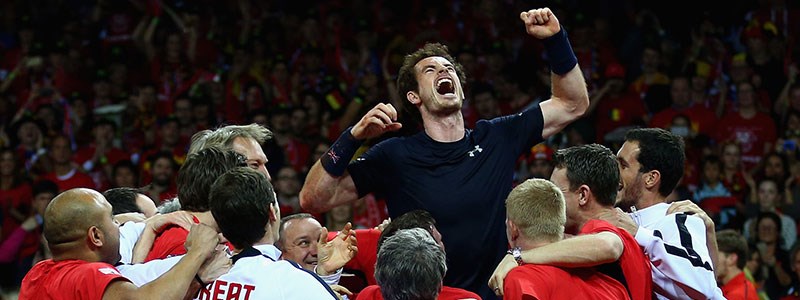Open 2010-2018: long waits for british tennis come to an end
• 8 MINUTE READ
Andy Murray brought an end to Britain’s long wait for a men’s Wimbledon champion and a Davis Cup triumph before Johanna Konta burst onto the scene to re-write records of her own. By Alex Sharp
“The wait is over!”
It is the line of commentary that will stay with Andy Murray forever.
Britain’s 77 years of waiting for a male champion at Wimbledon were brought to an end as the Scot dispatched then world No.1 Novak Djokovic 6-4 7-5 6-4 at a blazing hot Centre Court in 2013.
It was the title he truly craved, having famously given a tearful speech after losing his first final at SW19 against Roger Federer a year earlier.
"It was tough speaking after the match. I didn't know what to do with myself,” admitted an emotional Murray, who had won his maiden major at the US Open in 2012.
Boosted by ‘super coach’ Ivan Lendl back in his corner, Murray repeated the Wimbledon triumph in 2016, outclassing Milos Raonic in straight sets.

More milestones for Murray swiftly followed. Four successive trophies catapulted him to the top of the rankings, before he dispatched Djokovic in straight sets at the ATP World Tour Finals, thus claiming the year-end No.1 spot.
The now-30-year-old evidently thrives when representing Great Britain. His 2012 and 2016 Olympic gold medals were outstanding efforts, but arguably his standout showing so far was the 2015 Davis Cup run.
The Great Britain talisman put in a gladiatorial effort to win all 11 rubbers he played as Leon Smith’s men secured a first Davis Cup since 1936. The winning lob curling over Belgium’s David Goffin in Ghent was an iconic moment as Murray collapsed to the clay in disbelief.
Further British success has arrived in recent doubles events. Jonathan Marray lifted the men’s doubles trophy at Wimbledon 2012, before Heather Watson partnered Finland’s Henri Kontinen to mixed doubles glory at SW19 in 2016.
Jamie Murray and Bruno Soares were the pair to beat that year as Australian Open and US Open champions. A decade on from his first mixed crown, Murray entered the roll of honour alongside Martina Hingis at Wimbledon and the US Open in 2017.
The driving force on the WTA this decade has undoubtedly been Serena Williams, adding trophy after trophy to the already-glittering cabinet she assembled in the 2000s.

The likes of Victoria Azarenka, Li Na, Maria Sharapova, Petra Kvitova, Angelique Kerber, and Garbine Muguruza have challenged the reign of Serena with two Grand Slams each since the turn of the decade.
Navigating injuries, health issues, and the birth of her first child, Serena has still managed to claim 12 majors in the 2010s with her open stance, searing serving, and high-risk strategy.
Azarenka possesses an equally-destructive power game, pushing Williams the distance in two mesmerising US Open finals in 2012-13, but her home Slam was also the scene of a devastating defeat.
The hype surrounding the 2015 US Open in New York was off the charts. Serena had three Grand Slams in the bag, overcoming Sharapova (Melbourne), Lucie Safarova (Paris), and Muguruza (Wimbledon), and was tantilisingly close to a calendar slam.
However, gregarious Italian Roberta Vinci played the match of her life, springing across the court to roar back 2-6, 6-4, 6-4.
Williams would rebound once again and by 2017 was on the cusp of surpassing Steffi Graf for an Open Era record 23 Grand Slam singles titles.

There was nothing unusual regarding Serena storming through the draw, but in an astonishing secret, the 35-year-old clinched a seventh Australian Open while pregnant with her first child.
Aptly, Serena faced sister Venus in the silverware showdown exactly 20 years after their first professional meeting at Melbourne Park.
The Australian Open was where another British star began to rise. Johanna Konta became the first British woman since 1983 to reach a Grand Slam semi-final when she reached the last-four in Melbourne in 2016.
A year later Konta backed that up with another historic run, this time on the grass of Wimbledon. Not since 1978 and Virginia Wade had Britain celebrated a woman in the last-four of its home Slam, but Konta refreshed that record with a stunning quarter-final triumph over Simona Halep.
The Brit was unlucky to come up against a resurgent Venus in the last-four, going down in straight sets to the senior Williams sister, but home fans will be licking their lips at the prospect of another Konta run at Wimbledon in 2018.
While Serena was the force on the women’s side, the men’s game was gripped by the ‘Big Four’. Federer, Djokovic, Murray, and Rafael Nadal have dominated the sport in the 21st century – hence this grouped title.

Other than this all-conquering quartet, only Stan Wawrinka (three) and Marin Cilic (US Open 2014) have achieved Grand Slam success in the 2010s. That’s a staggering 29 out of 33 majors for the ‘Big Four’.
Also, underlying their dominance, Nadal has capitalised on his clay-court prowess to top the Masters 1000 leaderboard on 31, sneaking past Djokovic (30), Federer (27) and Murray (14). Only Andre Agassi breaks up their monopoly on 17 Masters to his name.
This decade Djokovic has swept 11 majors, which included three seasons of clinical, relentless play.
The Serbian in 2011, 2015, and 2016 was almost robotic in his winning ways. His defence, his elasticity and ability to retrieve almost any shot tortured the Tour.
His mental fortitude was exemplified in the 2012 Australian Open final with Nadal; the longest Grand Slam final at five hours and 53 minutes, which had two supreme athletes stretching every sinew of their bodies.
Djokovic ruled 5-7, 6-4, 6-2, 6-7(5), 7-5 in a match epitomising the brutality of the modern game. So much so that both players were being propped up by the net during the trophy presentation and required chairs to listen to the various speeches.

On the subject of marathons… how about a three-day thriller for entertainment?
Wimbledon provided the setting for the longest match in history in 2010. The towering John Isner pounded 113 aces past Nicolas Mahut, in the clash which began at 6.13pm on Tuesday June 22 and, due to fading light each day, finished at 4.47pm on Thursday June 24.
The final set in itself lasted over eight hours, before Isner completed an 11 hours, five minute epic 6-4, 3-6, 6-7 (7), 7-6(3), 70-68.
Poor Mahut won more points (502) than Isner (478) and still lost, but both their names now adorn a plaque to mark the occasion at Court 18 at the All England Club.
Another outrageous figure was the 299 piercing winners that fearless Jelena Ostapenko struck en route to a maiden title, the French Open, in the summer of 2017.
Similarly, Wawrinka shattered Djokovic’s career-slam dreams with a rocket-fuel exhibition of tennis in the 2015 Roland Garros final. 12 months later, Djokovic’s tears turned to triumph as he completed his personal Grand Slam haul in Paris.

Prize money has incrementally risen through the 21st century, but 2010 provided a landmark amount of zeros, with Wimbledon the first Grand Slam to offer £1 million for their singles champions. Believe it or not, the fee is double that now at the majors.
Who could forget a teenage Nick Kyrgios’ ‘tweener’ drop shot in the process of defeating Nadal at Wimbledon four years ago? Well, these victories are still rare and the established legends of the sport still rule the roost when it matters.
The ‘ageing’ of professional tennis has been brought about by technology, rehabilitation, nutrition, and players’ investment in strength and conditioning. Simply, the pros can compete at the highest level well into their late Thirties now.
Longevity has been a key component of Federer and Nadal’s legacy.
Five years had passed since the Swiss maestro lifted a Grand Slam trophy and was on the verge of being written off. However, Federer had the last laugh and in 2017 put together one of his finest seasons – seven titles and just five losses in a return to his pomp.
It was fitting his trophy-laden 2017 ignited with a duel with Nadal. In a pulsating Australian Open final, Federer unleashed his full artillery to battle back from 1-3 in the decider. It marked his first victory over his fiercest on-court rival in a Grand Slam match away from the grass courts of SW19.

But it wasn’t all bad news for Rafa fans. That summer Nadal reaffirmed his status as the true ‘King of Clay’ with ‘La Decima’ at Roland Garros. 12 years on from his first French Open as a teenager, Nadal still had his opponents crumbling on clay and lifted his 10th title to post a 79-2 record in Paris.
The 200th Grand Slam of the Open Era came at the 2018 Australian Open. On the women’s side, Caroline Wozniacki quelled the spirit of Halep to taste major success finally in a 7-6(2), 3-6, 6-4 rollercoaster.
On the men’s side, Federer’s fairy tale resurgence continued as he was reduced to tears while thanking his fans, having just retained his Melbourne crown.
The fan-favourite even had the legendary Rod Laver taking a picture on his phone while Federer held the trophy aloft.
An iconic moment to round off the Open Era of Grand Slams so far…





